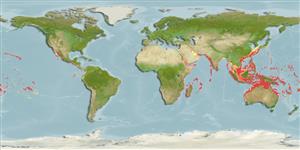Common names from other countries
分类 / Names
俗名 | 同种异名 | Catalog of Fishes(属, 种) | ITIS | CoL | WoRMS | Cloffa
Teleostei >
Acanthuriformes (Surgeonfishes)
鱸形目 (Surgeonfishes) >
Chaetodontidae (Butterflyfishes)
蝴蝶魚科 (Butterflyfishes)
Etymology: Forcipiger: Latin, forceps = instrument of the pincers kind used for seizing and holding objects, esp. In surgical and obstetric operations + latin, gero = to carry; 1634 (Ref. 45335).
More on authors: Jordan & McGregor.
Environment: milieu / climate zone / depth range / distribution range
生态学
海洋 礁区鱼类; 非迁移的; 深度上下限 0 - 145 m (Ref. 89467). 熱帶; 36°N - 32°S, 30°E - 79°W
Indo-Pacific: Red Sea and East Africa (Ref. 12484) to the Hawaiian and Easter islands, north to southern Japan, south to Lord Howe Island; throughout Micronesia. Eastern Pacific: southern Baja California, Mexico and from the Revillagigedo and Galapagos Islands (Ref. 5227, 11482).
印度-太平洋: 紅海與東非 (參考文獻 12484) 到夏威夷與復活島, 北至日本南部, 南至羅得豪島; 在密克羅尼西亞各處。 東太平洋: 墨西哥的下加利福尼亞南部與從雷維拉吉哥多島與加拉巴哥群島.(參考文獻 5227,11482)
大小 / 重量 / 年龄
Maturity: Lm ? range ? - ? cm
Max length : 22.0 cm TL 雄鱼/尚未辨别雌雄; (Ref. 9710); 最大年龄: 18 年 (Ref. 72479)
背棘 (总数) : 12 - 13; 背的软条 (总数) : 19 - 25; 臀棘: 3; 臀鳍软条: 17 - 19.
F. flavissimus 有相当短的超过 F. longirostris 吻部有一个较大的嘴,较高的背棘计数, 而且在胸上缺乏中心深色的鳞片.
Common in exposed seaward reefs but also found in lagoon reefs (Ref. 9286). Benthopelagic (Ref. 58302). Solitary or in small groups of up to 5 individuals (Ref. 9286). Adults usually in pairs (Ref. 48636). Feed on a wide variety of animal prey including hydroids, fish eggs, small crustaceans but prefers tube feet of echinoderms, pedicilaria of sea urchins, and polychaete tentacles (Ref. 1602). Oviparous (Ref. 205), monogamous (Ref. 52884). Form pairs during breeding (Ref. 205). Second most important export in Hawaii (Ref. 37816). Minimum depth reported taken from Ref. 128797.
常见于裸露的临海礁石也发现于舄湖礁。 独居性或形成小群鱼群向上到 5个个体.(参考文献 9286) 成鱼通常成对出现。 (参考文献 48636) 捕食各式各样的动物猎物包括水息虫,鱼卵, 小型甲壳动物但是偏爱棘皮动物的管足虫,海胆的 pedicilaria 与多毛类的触须.(参考文献 1602) 卵生的 (参考文献 205) ,一夫一妻的.(参考文献 52884) 形式在繁殖的时候配对。 (参考文献 205) 在夏威夷的第二重要的输出.(参考文献 37816)
Life cycle and mating behavior
Maturities | 繁殖 | Spawnings | Egg(s) | Fecundities | 仔鱼
Distinct pairing (Ref. 205). Monogamous mating is observed as both obligate and social (Ref. 52884).印度-太平洋: 紅海與東非 (參考文獻 12484) 到夏威夷與復活島, 北至日本南部, 南至羅得豪島; 在密克羅尼西亞各處。 東太平洋: 墨西哥的下加利福尼亞南部與從雷維拉吉哥多島與加拉巴哥群島.(參考文獻 5227,11482)
Myers, R.F., 1991. Micronesian reef fishes. Second Ed. Coral Graphics, Barrigada, Guam. 298 p. (Ref. 1602)
CITES (Ref. 128078)
Not Evaluated
人类利用
渔业: 没有兴趣; 水族馆: 商业性
工具
特别资料
下载 XML
网络资源
Estimates based on models
Preferred temperature (Ref.
115969): 24.3 - 28.8, mean 27.5 (based on 710 cells).
Phylogenetic diversity index (Ref.
82804): PD
50 = 0.6250 [Uniqueness, from 0.5 = low to 2.0 = high].
Bayesian length-weight: a=0.02239 (0.01117 - 0.04486), b=3.02 (2.85 - 3.19), in cm Total Length, based on LWR estimates for this (Sub)family-body shape (Ref.
93245).
营养阶层 (Ref.
69278): 3.1 ±0.2 se; based on diet studies.
回复力 (Ref.
120179): 高度, 族群倍增时间少于 15个月 (Preliminary K or Fecundity.).
Fishing Vulnerability (Ref.
59153): Low vulnerability (12 of 100).
